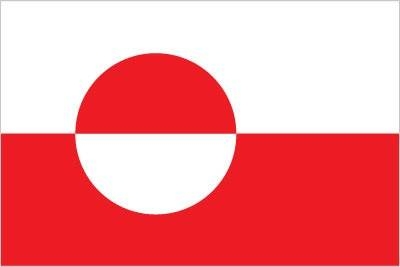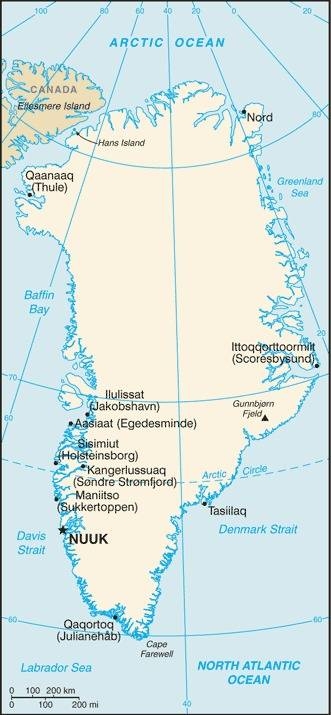65 Greenland (Denmark)

Two equal horizontal bands of white (top) and red with a large disk slightly to the hoist side of center – the top half of the disk is red, the bottom half is white. The design represents the sun reflecting off a field of ice. The colors are the same as those of the Danish flag and symbolize Greenland’s links to the Kingdom of Denmark.
Flag courtesy of the CIA World Factbook

Map courtesy of the CIA World Factbook

Carvings in Qaqortoq.
Photo courtesy of the CIA World Factbook
Last updated on October 22, 2025
Government
According to Britannica, in 1979 the Danish government granted home rule to Greenland (Kalaallit Nunaat). Under this agreement, Greenland remained part of the Danish realm, and each Greenlander was a Danish citizen, enjoying equal rights with all other Danes. Denmark retained control of the island’s constitutional affairs, foreign relations, and defense, while Greenland maintained jurisdiction over economic development, municipal regulations, taxes, education, the social welfare system, cultural affairs, and the state church. Mineral resources were managed jointly by Denmark and Greenland. It was perhaps this last point that inspired Greenlanders to vote overwhelmingly in 2008 to increase their autonomy from Denmark, and Greenland is now officially designated a self-governing overseas administrative division of Denmark. Under the expanded home rule agreement, which took effect on June 21, 2009, Greenland retained a greater percentage of oil and mineral revenue. It also managed virtually all domestic affairs, including criminal justice, and Greenlandic supplanted Danish as the official language of government. Denmark, in collaboration with Greenlandic political leaders, continued to manage the island’s foreign relations and defense.
The centre of power in Greenland is the Inatsisartut, a parliament elected to four-year terms by all adults age 18 and older. A number of parties have been represented in the Inatsisartut. Among them are Siumut, a social democratic party that favours self-determination while maintaining close relations with Denmark; the Demokratiit party, created by a breakaway faction of Siumut; Atassut, a more conservative party that has supported Greenland’s historical relations with Denmark; and Inuit Ataqatigiit, which calls for full independence from Denmark. The Inatsisartut elects the prime minister as well as the other members of the Landsstyre, a council that assumes the island’s executive responsibilities. The prime minister is typically the leader of the majority party in the parliament. Greenland’s voters also elect two representatives to the Danish parliament (Folketing). An official known as the high commissioner represents the Danish government in Greenland.
Greenland Government
Greenland government – Greenland was ruled by Denmark from the early 18th century until 1979, when home rule began. In 2009, Greenland approved the Self-Government Act in a referendum. The act means that Greenland can assume additional areas of responsibility. However, foreign policy, defense policy, and security policy cannot be transferred to Greenland.
Airspace
SkyVector – Google Maps – ADS-B Exchange
ICAO countries publish an Aeronautical Information Publication (AIP). This document is divided into three parts: General (GEN), En Route (ENR) and Aerodromes (AD). ENR 1.4 details the types of airspace classes they chose to adopt from classes A through G.
Naviair
Naviair has been designated by the Danish Civil Aviation and Railway Authority to provide air navigation services.
They share some material on drones on their website. You should check out this interactive map.
Drone Regulations
See a number of fantastic drone clips videos on visit Greenland channel
Advanced Air Mobility (AAM) Regulations & Policies
None found by the author.
However, should you, the reader, happen to stumble across something to the contrary, please email the author at FISHE5CA@erau.edu and you may be mentioned in the ACKNOWLEDGEMENTS section of this book by way of thanks for contributing to this free eBook!
Advanced Air Mobility (AAM) News
None found by the author.
However, should you, the reader, happen to stumble across something to the contrary, please email the author at FISHE5CA@erau.edu and you may be mentioned in the ACKNOWLEDGEMENTS section of this book by way of thanks for contributing to this free eBook!
Short Essay Questions
Scenario-Based Question
You have been hired by a Drone Startup Company. Your boss has immediately assigned this job to you.
They need you to prepare a one-page memo detailing the legalities of using a drone to film over Qaqortoq, pictured above.
They need you to mention any national laws and local ordinances.
They specifically want to know what airspace (insert pictures) you will be operating in and whether or not you need an airspace authorization.
Does it matter whether or not you are a citizen of the country?
Lastly, there is a bonus for you if, as you scroll through this chapter, you find any typos or broken links!
Short Essay Questions
- What are the drone categories?
- How is registration addressed?
- How is remote ID addressed?
- What are the model aircraft rules?
- What are the commercial drone rules?
- Are there waivers or exemptions to the rules? If so, for what?
- Would you share a link to an interactive airspace map?
- How is BVLOS addressed?
- How can you fly drones at night?
- How can you fly drones over people?
- Where do you find drone NOTAMs?
- What are the rules for drone maintenance?
- What are the rules for an SMS program?
- What are some unique rules not mentioned above?
- What are the C-UAS rules?
- What are the AAM rules?

